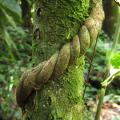
Boundary condition

Posts: 8617 Joined: 30-Aug-2008 Last visit: 29-Nov-2025 Location: square root of minus one
|
Noticed this, found it interesting: https://psychedelicrevie...otonin-5-ht2a-receptor/
Quote:
Compound 5-HT1A 5-HT2A 5-HT2B 5-HT3
4-HO-TMT 4,400 670.0 120.0 >10,000
4-AcO-TMT >10,000 >10,000 >10,000 >10,000
Psilocin 567.4 107.2 4.6 >10,000
Psilocybin >10,000 >10,000 98.7 >10,000
4-AcO-TMT showed no binding activity at any of the receptors tested. However, 4-HO-TMT had activity at 5-HT1A, 5-HT2A, and 5-HT2B. Agonist activity at 5-HT2A is regarded by experts as the hallmark of psychedelic activity.16
Although 4-HO-TMT showed less binding affinity at 5-HT2A than psilocin, the authors concluded that the Ki values were comparable (670.0 nM and 107.2 nM, respectively). Also, the data showed that 4-HO-TMT has a similar affinity for 5-HT2B compared to psilocybin.
Recall that one of the hypotheses Chadeayne et al. was testing was that aeruginascin’s active metabolite 4-HO-TMT would have an affinity for 5-HT3 like bufotenine. The data showed this was not the case. The Ki for 4-HO-TMT at 5-HT3 was >10,000 nM.
[...]
Despite the value gained from these tests, it is unclear why Chadeayne et al. did not test the two compounds at nicotinic acetylcholine receptors. The results may have shed some light on the possible role of aeruginascin (or its metabolite) in the phenomenon known as wood lover paralysis.
“There is a way of manipulating matter and energy so as to produce what modern scientists call 'a field of force'. The field acts on the observer and puts him in a privileged position vis-à-vis the universe. From this position he has access to the realities which are ordinarily hidden from us by time and space, matter and energy. This is what we call the Great Work." ― Jacques Bergier, quoting Fulcanelli
|
|
|
|
|

DMT-Nexus member
Posts: 1111 Joined: 18-Feb-2017 Last visit: 12-Jul-2024
|
Thanks. This article: Wood Lover Paralysis From Magic Mushrooms: The Aeruginascin Hypothesissuggests the potential paralytic action of aeruginascin after dephosphorylation may be similar to that of bufotenidine (a known paralytic in toad venom) and mediated via 5-HT3. Quote:Of the 7 known serotonin receptor families, 5-HT3 is unique in that it works via a different mechanism than the others. Serotonin receptor families 1, 2, and 4-7 are G-protein coupled receptors that have a distinct structure of 7 coils that traverse the cell membrane.7 When these receptors bind serotonin and other compounds, they activate signaling pathways in the cell that use phosphatidylinositol and cyclic AMP (cAMP). The 5-HT3 receptor, however, works via a ligand-gated sodium and potassium channel. For these receptors, the binding of serotonin opens ion channels, allowing sodium and potassium to enter the cell, leading to an excitatory response. The ion-gated mechanism by which 5-HT3 receptors work is more like the way acetylcholine binds to neurons at neural-muscle junctions in the body, creating signaling for muscles to contract.
Studies have found that the frog venom bufotenidine (the one that causes paralysis) binds to the 5-HT3 receptor with ten times the affinity of serotonin.8 Recall the structural similarities between bufotenidine and aeruginascin (Figure 5). If aeruginascin is dephosphorylated in the body and carbon 4 receives a hydroxyl group as a result, then the only difference between the paralysis-causing bufotenidine and the Wood Lover Paralysis-causing candidate aeruginascin is whether carbon 4 or 5 has the hydroxyl group. Both molecules have the charged and reactive trimethylammonium group, so it is feasible they may affect the same receptor and cause the same effect. Also, based on its chemical structure, bufotenidine may be confined to the PNS and not be able to cross the blood-brain barrier, just like aeruginascin. For those who work with P. azurescens, a simple experiment comes to mind: ginger contains a 5-HT3 antagonist; would something as simple as the concurrent ingestion of ginger prevent WLP?
|
|
|

DMT-Nexus member
 
Posts: 12340 Joined: 12-Nov-2008 Last visit: 02-Apr-2023 Location: pacific
|
Interesting post. A similar?.. experience of paralysis is also reported to happen with ingestion of other woodlovers. I can attest to this having been born and raised in the PNW. I have a fair ammount of experience picking and eating especially psilocybe cyanescens, and while the paralysis is usually absent, there are some specimens that will cause it - and it's pretty damn powerful. I once was entirely unable to move, it was all I could to just lay on the ground in the woods right where I collapsed. Once it ended, it ended and I was fine..I got up and walked away. Others present who had also ingested the cyans were alarmed, but I had eaten a good handful that day and only one effected in this way. I have met many people here with similar tales to tell. So my question is now, what is causing this effect in species not found to contain aeruginascin? I have questioned myself as to my ID skills back then. It is possible I have eaten misidentified species...but def not an Inocybe...and azures which are most commonly associated with paralysis are not found in BC. More questions I guess. Long live the unwoke.
|
|
|

DMT-Nexus member
 
Posts: 3968 Joined: 21-Jul-2012 Last visit: 15-Feb-2024
|
Quote:So my question is now, what is causing this effect in species not found to contain aeruginascin? Is it not present in cyans? Because I've most definitely experienced it from them. Didn't read this thread first, and posted the same link Jagube posted above in another active thread, sorry for the redundancy. Sine experientia nihil sufficienter sciri potest -Roger Bacon
*γνῶθι σεαυτόν*
|
|
|

DMT-Nexus member
Posts: 1111 Joined: 18-Feb-2017 Last visit: 12-Jul-2024
|
A question for the chemists: how easy would it be to remove aeruginascin?
I remember reading aeruginascin was difficult to quantify as its extraction requires a different technique; does that provide a hint?
|
|
|

DMT-Nexus member
Posts: 1111 Joined: 18-Feb-2017 Last visit: 12-Jul-2024
|
jamie wrote:I have a fair ammount of experience picking and eating especially psilocybe cyanescens, and while the paralysis is usually absent, there are some specimens that will cause it - and it's pretty damn powerful. Did you experience this with dried or fresh mushrooms? And were all the mushrooms collected from the same cluster / spot or different spots? I've heard of WLP being more likely to occur with P. azurescens grown in one particular coastal area, so it may have to do with substrate composition. If it's single specimens, perhaps homogenization could reduce its impact.
|
|
|

Boundary condition

Posts: 8617 Joined: 30-Aug-2008 Last visit: 29-Nov-2025 Location: square root of minus one
|
There are a number of possibilities when it comes to the variability of aeruginascin content of fungal specimens. A close look at the secondary metabolism suggests that there would be either a different enzyme required for the addition of the third methyl group, or a slightly mutated version of the methylating enzyme which makes the third methylation more likely. This is discounting the possible involvement of endomycotic species such as microbial or viral organisms that might influence the cellular chemistry or do the third methylation themselves - the "Infected Mushroom hypothesis"! The other angle that should be fairly obvious is that a timescale effect may be in play. Older mushrooms will have had more time for more methylation to occur - but caution is advised with this thinking as we know that younger carpophore specimens can present impressive concentrations of the mono- and dimethyl derivatives. This make me wonder whether the age of the mycelial body of the fungus could play a role in determining the aeruginascin concentration of a mushroom sample. Of course, we shouldn't jump the gun with our assumptions here - we don't know for sure what the pharmacological effects of aeruginascin actually are but given the close structural parallels with bufotenidine and the similar neuromuscular blocking properties of candicine it looks like the simplest and most likely candidate for now. “There is a way of manipulating matter and energy so as to produce what modern scientists call 'a field of force'. The field acts on the observer and puts him in a privileged position vis-à-vis the universe. From this position he has access to the realities which are ordinarily hidden from us by time and space, matter and energy. This is what we call the Great Work." ― Jacques Bergier, quoting Fulcanelli
|